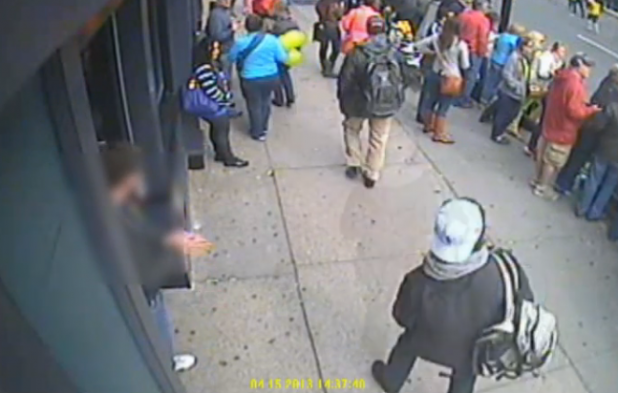 Law enforcement agents had to watch video segments from the bombing hundreds of times over a few days in order to construct proper timelines[/caption] Last week’s horrific bombing of the Boston Marathon presented the FBI and Boston Police Department with an enormous challenge: find the perpetrators and stop them before they could escape or commit another atrocity. It would require sifting though mountains of physical evidence—everything from victims’ torn clothing to bomb fragments scattered around the scene—as well as thousands of photos and videos shot by bystanders. If there was ever a time to deploy Big Data tools such as facial-recognition technology, which can find matches within enormous image databases, this was it. Even as law enforcement scrambled to analyze the data with the platforms available, crowds of amateur sleuths took to online forums to pick through data en masse—a very real example of crowdsourcing, another much-hyped Big Data method. But in the end, the killing of bombing suspect Tamerlan Tsarnaev—killed in a shootout with the Boston police—and the capture of his younger brother Dzhokhar came down to a more old-fashioned brand of police work. Despite their hype, Big Data techniques didn’t prove a magic bullet in this case—but that could change in coming years, as the underlying tools become more sophisticated.
Law enforcement agents had to watch video segments from the bombing hundreds of times over a few days in order to construct proper timelines[/caption] Last week’s horrific bombing of the Boston Marathon presented the FBI and Boston Police Department with an enormous challenge: find the perpetrators and stop them before they could escape or commit another atrocity. It would require sifting though mountains of physical evidence—everything from victims’ torn clothing to bomb fragments scattered around the scene—as well as thousands of photos and videos shot by bystanders. If there was ever a time to deploy Big Data tools such as facial-recognition technology, which can find matches within enormous image databases, this was it. Even as law enforcement scrambled to analyze the data with the platforms available, crowds of amateur sleuths took to online forums to pick through data en masse—a very real example of crowdsourcing, another much-hyped Big Data method. But in the end, the killing of bombing suspect Tamerlan Tsarnaev—killed in a shootout with the Boston police—and the capture of his younger brother Dzhokhar came down to a more old-fashioned brand of police work. Despite their hype, Big Data techniques didn’t prove a magic bullet in this case—but that could change in coming years, as the underlying tools become more sophisticated.
Crowdsourcing, Facial Recognition Failed in Boston Bombing Aftermath
[caption id="attachment_9325" align="aligncenter" width="618"]  Law enforcement agents had to watch video segments from the bombing hundreds of times over a few days in order to construct proper timelines[/caption] Last week’s horrific bombing of the Boston Marathon presented the FBI and Boston Police Department with an enormous challenge: find the perpetrators and stop them before they could escape or commit another atrocity. It would require sifting though mountains of physical evidence—everything from victims’ torn clothing to bomb fragments scattered around the scene—as well as thousands of photos and videos shot by bystanders. If there was ever a time to deploy Big Data tools such as facial-recognition technology, which can find matches within enormous image databases, this was it. Even as law enforcement scrambled to analyze the data with the platforms available, crowds of amateur sleuths took to online forums to pick through data en masse—a very real example of crowdsourcing, another much-hyped Big Data method. But in the end, the killing of bombing suspect Tamerlan Tsarnaev—killed in a shootout with the Boston police—and the capture of his younger brother Dzhokhar came down to a more old-fashioned brand of police work. Despite their hype, Big Data techniques didn’t prove a magic bullet in this case—but that could change in coming years, as the underlying tools become more sophisticated.
Law enforcement agents had to watch video segments from the bombing hundreds of times over a few days in order to construct proper timelines[/caption] Last week’s horrific bombing of the Boston Marathon presented the FBI and Boston Police Department with an enormous challenge: find the perpetrators and stop them before they could escape or commit another atrocity. It would require sifting though mountains of physical evidence—everything from victims’ torn clothing to bomb fragments scattered around the scene—as well as thousands of photos and videos shot by bystanders. If there was ever a time to deploy Big Data tools such as facial-recognition technology, which can find matches within enormous image databases, this was it. Even as law enforcement scrambled to analyze the data with the platforms available, crowds of amateur sleuths took to online forums to pick through data en masse—a very real example of crowdsourcing, another much-hyped Big Data method. But in the end, the killing of bombing suspect Tamerlan Tsarnaev—killed in a shootout with the Boston police—and the capture of his younger brother Dzhokhar came down to a more old-fashioned brand of police work. Despite their hype, Big Data techniques didn’t prove a magic bullet in this case—but that could change in coming years, as the underlying tools become more sophisticated.
 Law enforcement agents had to watch video segments from the bombing hundreds of times over a few days in order to construct proper timelines[/caption] Last week’s horrific bombing of the Boston Marathon presented the FBI and Boston Police Department with an enormous challenge: find the perpetrators and stop them before they could escape or commit another atrocity. It would require sifting though mountains of physical evidence—everything from victims’ torn clothing to bomb fragments scattered around the scene—as well as thousands of photos and videos shot by bystanders. If there was ever a time to deploy Big Data tools such as facial-recognition technology, which can find matches within enormous image databases, this was it. Even as law enforcement scrambled to analyze the data with the platforms available, crowds of amateur sleuths took to online forums to pick through data en masse—a very real example of crowdsourcing, another much-hyped Big Data method. But in the end, the killing of bombing suspect Tamerlan Tsarnaev—killed in a shootout with the Boston police—and the capture of his younger brother Dzhokhar came down to a more old-fashioned brand of police work. Despite their hype, Big Data techniques didn’t prove a magic bullet in this case—but that could change in coming years, as the underlying tools become more sophisticated.
Law enforcement agents had to watch video segments from the bombing hundreds of times over a few days in order to construct proper timelines[/caption] Last week’s horrific bombing of the Boston Marathon presented the FBI and Boston Police Department with an enormous challenge: find the perpetrators and stop them before they could escape or commit another atrocity. It would require sifting though mountains of physical evidence—everything from victims’ torn clothing to bomb fragments scattered around the scene—as well as thousands of photos and videos shot by bystanders. If there was ever a time to deploy Big Data tools such as facial-recognition technology, which can find matches within enormous image databases, this was it. Even as law enforcement scrambled to analyze the data with the platforms available, crowds of amateur sleuths took to online forums to pick through data en masse—a very real example of crowdsourcing, another much-hyped Big Data method. But in the end, the killing of bombing suspect Tamerlan Tsarnaev—killed in a shootout with the Boston police—and the capture of his younger brother Dzhokhar came down to a more old-fashioned brand of police work. Despite their hype, Big Data techniques didn’t prove a magic bullet in this case—but that could change in coming years, as the underlying tools become more sophisticated.


